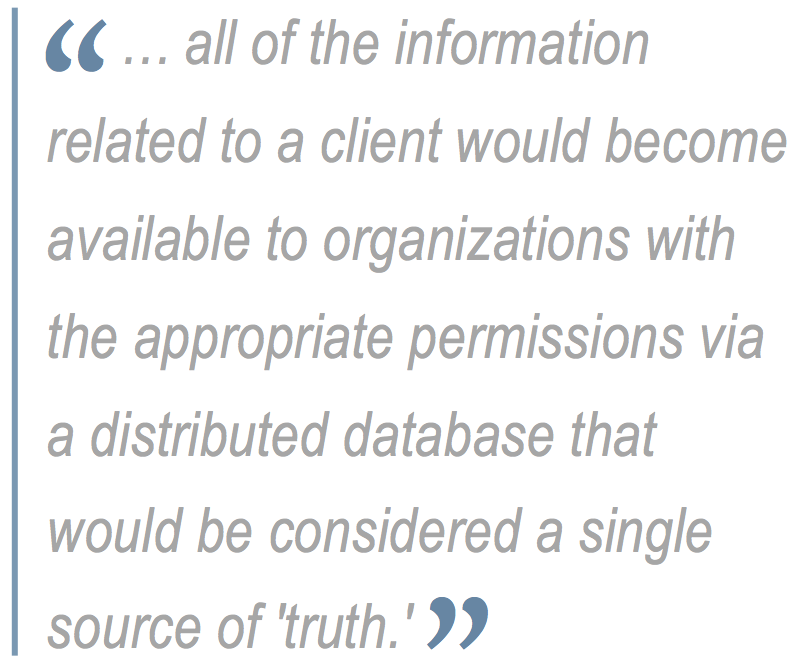


AML-KYC regs are a helpful tool for fighting crime, but a headache for ATM operators. Could there be a simple, cost-effective, surefire solution to the problem — something less punitive than Operation Choke Point? Could that something be distributed ledger technology?
 photo istock
photo istock
by Chrysostomos Filippou
The innovation of blockchain technology is credited to a person or a group of people under the name Satoshi Nakamoto. Although this name is connected to the creation of blockchain, an undeniably ingenious invention, not much is known about Nakamoto's real identity.
Blockchain became popular as the engine driving bitcoin and other virtual currencies; however, it seems to be more than this, especially when it comes to the potential of blockchain to transform and modernize the global economy.
Blockchain technology is a distributed database, which differs from relational databases that currently dominate the market. Transparency, security and efficiency are improved in a distributed database, which does not depend on the control and integrity of one party that manages a single central repository.
How blockchain could support KYC and AML efforts
Among others, know your customer and anti-money laundering are potential blockchain use cases for blockchain technology.
Currently, institutions offering financial or professional services are obliged to follow time-consuming and expensive practices for each new customer. The adoption of blockchain technology could lead to the reduction of AML and KYC costs thanks to its cross-institution client verification capability, as well as its effectiveness in monitoring and analyzing data required for AML and KYC checks.
 With blockchain, the verification of a client or the legality of a transaction could take place just once, with the final result cryptographically stored in a blockchain.
With blockchain, the verification of a client or the legality of a transaction could take place just once, with the final result cryptographically stored in a blockchain.
Organizations such us banks or administration services providers would be able to get rid of the multistep AML and KYC processes as they would have the option to access a distributed database that would provide them with the final results of those processes.
More specifically, all of the information related to a client would become available to organizations with the appropriate permissions via a distributed database that would be considered a single source of "truth."
(It is worth mentioning here that blockchain is an immutable technology and once data is verified and stored in the distributed database it cannot be manipulated — only updated.)
The speed and ease with which blockchain allows participants to obtain useful and quality information make it very appealing to regulators, banks and law enforcement agencies around the world.
Blockchain is a promising, but nascent, technology
Blockchain is a nascent technology and its adoption implies change. And when something is new and brings change can be challenging, especially if it is related to sensitive data and legal matters.
The value of this emerging and growing technology, which has strong advocates, still needs to be clarified since there are challenges that need to be taken into consideration before its adoption, including:
With this in mind, a solution that will handle view access should be explored and carefully studied before implementation, since the immutable nature of blockchain needs to be protected.
However, things can become more complicated when banks are under different jurisdictions, or when they want to follow in-house KYC procedures that suit their own risk appetite and client profiles.
To sum up, the power of blockchain technology is driven by the network nodes. Each node could be a market participant — i.e., tax authorities, company registries, law enforcement bureaus, media houses, judicial bodies, banks and corporates. This implies collaboration among market participant to develop a mutually beneficial solution.
On the other hand, the KYC and AML space is a domain of enormous risk and, hence, investment. Banks and fintechs are now exploring this challenge, but it is not entirely clear yet how the particular blockchain use-case will evolve.
Chrysostomos Filippou is interested in leveraging technology to solve business issues, improve business performance, and deliver flexible, simple, cost-effective and customer friendly solutions. He is particularly interested in blockchain technology and its utilization across various industries. https://www.linkedin.com/in/cfilippou/
Sign up now for the ATM Marketplace newsletter and get the top stories delivered straight to your inbox.
Privacy PolicySeptember 9-11, 2024 | Charlotte, NC